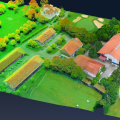
'This is a significant step towards making ecosystem data more accessible to the ecosystem science community,' said TERN Director, Prof Tim Clancy, as he announced the public release this month of the TERN Data Discovery Portal (TDDP).
For the first time, the TDDP allows users to search for and explore data generated by a wide range of ecosystem disciplines, from a single point of entry. Metadata is regularly harvested from all across TERN into the TDDP, enabling it to play a novel integrative role for Australian ecosystem science. The portal supports both text and map-based searches, and users can search for metadata records based on regional classifications including states/territories, the Interim Biogeographic Regionalisation for Australia (IBRA), natural resource management zones, and climate zones. Once suitable metadata is located, users are directed to the data set to download from the relevant TERN Facility portal.
The metadata information available in the TDDP consists of descriptive information about the datasets and data custodians, data access and rights, spatial coverage of data, and details about accessing the data.
'The TDDP greatly improves the discoverability of terrestrial ecosystem data in Australia,' said Professor Andy Lowe, TERN Associate Science Director. 'As a result we anticipate an increase in data sharing and re-use of ecosystem data.'
The development of the portal was driven by the needs of the ecosystem science community. In the initial development stages, interviews with primary stakeholders helped the portal development team to identify and understand requirements for data access and usage, along with impediments that may affect regular work. Exploration of various user scenarios helped to further clarify the data needs of different users, and general stakeholder expectations of data infrastructure like the TDDP.
In further stages of development, two collaborative design workshops were held with targeted stakeholders. The participants for these workshops included researchers, decision-makers and policy-makers from a range of organisations, institutions and agencies. Through these workshops the portal development team were able to:
- better understand how researchers and policy-makers currently find ecosystem data in Australia, what data systems they use, and what they like and dislike about these systems;
- understand some of the current issues associated with accessing and using research data;
- understand users expected functionalities and features from the TDDP; and
- get feedback on a prototype of the TDDP.
Finally, one-to-one usability testing was conducted with six representatives from the stakeholder community to understand how users interact with the TDDP. This enabled the portal team to identify and resolve any remaining design flaws in the prototype system.
“The TERN Data Discovery Portal has been designed with the end-user in mind,” noted Prof Stuart Phinn, TERN Associate Science Director. “As a result, the TDDP is a useful tool that the Australian ecosystem science community can start using immediately to access a wealth of Australian ecosystem data.”
To date, the TDDP has published around 750 records from six TERN facilities. These numbers will grow considerably over the next few months.
The TERN Data Discovery Portal is available now at http://portal.tern.org.au/, and feedback can be provided using the ‘Contact’ tab within the Portal.







